Valentín Ferraz y Barrau facts for kids
Quick facts for kids
The Most Excellent
Valentín Ferraz
|
|
|---|---|
 |
|
| Prime Minister of Spain | |
| In office 12 August 1840 – 28 August 1840 |
|
| Monarch | Isabella II |
| Preceded by | Antonio González |
| Succeeded by | Modesto Cortázar |
| Personal details | |
| Born |
Valentín Ferraz y Barrau
|
| Nationality | Spanish |
Valentín Ferraz y Barrau (born in Huesca, Spain, in 1792 – died in Madrid, Spain, in 1866) was an important Spanish military leader and politician. He fought in two major wars: the Peninsular War in Spain and the Peruvian War of Independence in South America. Later, he became involved in Spanish politics during the time of Isabella II of Spain. He even served as Prime Minister of Spain for a short time in 1840 and was also the Mayor of Madrid.
Valentín Ferraz came from a well-known family that had been important since the 1100s in the Benasque Valley. Many people from his family became famous religious leaders, politicians, lawyers, and military experts. His uncle, Antonio Cornel y Ferraz, was the Spanish Minister of War for King Charles IV of Spain. His cousins, Jose Ferraz y Cornel and Francisco Javier Ferraz y Cornel, also held high positions during Queen Isabella II's rule.
Fighting for Spain's Freedom
In 1808, when Valentín was a young cadet (a military trainee), he was part of the King's Dragoon Regiment. This was when Napoleon's French army invaded Spain. Valentín was in the city of Zaragoza when it was attacked. After two months of very tough fighting, the city surrendered, and he was captured by the French.
However, Valentín was very brave and managed to escape! He rejoined the Spanish army, and because of his daring escape, he was promoted to lieutenant in 1809. That same year, he fought in the Valencia campaign against the French army. He was in many battles and small fights until Valencia fell to the French.
Things started to change for Spain. Many French soldiers left Spain to help Napoleon in his war in Russia. Also, the Duke of Wellington and his army began an attack from Portugal. These events helped the Spanish and their allies push the French out of Spain. Valentín's regiment fought in La Mancha, south of Madrid, where he showed great courage. After the war, he became a Captain. He then asked to be sent to South America to fight for Spain there.
Battles in Peru
In 1815, Valentín joined a regiment called Cazadores del Rey (Royal Hunters). This group was sent to Peru to help the Spanish army there. They were fighting against people who wanted Peru to be independent from Spain. Valentín sailed from Cadiz, Spain, in 1816. He landed in Arica, Peru, and then traveled to the war zone.
As a Captain, he led a group of Grenadier Guards. He fought in areas like Tarija, Jujuy Province, and Salta Province. His troops helped Spain take back these lands that had been taken by the Argentine independence movement. Valentín was a skilled cavalry officer, meaning he was good at leading soldiers on horseback. His bravery and leadership were noticed by others.
Later, the Spanish army in Peru faced more challenges. Valentín's regiment was sent to help another part of the army. However, this campaign did not go well and had to be stopped. The troops returned to Cusco. The war ended with the Capitulation of Ayacucho on December 9, 1824. This was a treaty that made Peru an independent country. After nine years, Valentín returned to Spain in 1825.
A Leader in Spain
Back in Spain, Valentín Ferraz continued to rise in his military and political career. He was helped by General Baldomero Espartero. Valentín always believed in "liberal ideas," which meant he supported freedom and change for Spain. He held many important jobs, including:
- Lieutenant General of the Armies
- Inspector General of the National Militia
- Member of important advisory groups
- Congressman and Senator for Huesca
- Mayor of Madrid
- War Minister four times
- Prime Minister of Spain in 1840
One of his most notable achievements was leading the Directorate General of Cavalry. He showed great leadership and started an important Academy for Weaponry in Alcalá de Henares. Because of this, he was called the "Spanish Cavalry Regenerator" (meaning he helped improve and renew the Spanish cavalry).
In 1865, a year before he died, a street in Madrid was named after him: calle Valentín Ferraz. This street is still named after him today. A famous Spanish politician, Pablo Iglesias, later died in a house on this street. The building now serves as a training center for politicians, and it keeps Valentín's name to honor his service to Spain.
See also
 In Spanish: Valentín Ferraz para niños
In Spanish: Valentín Ferraz para niños

